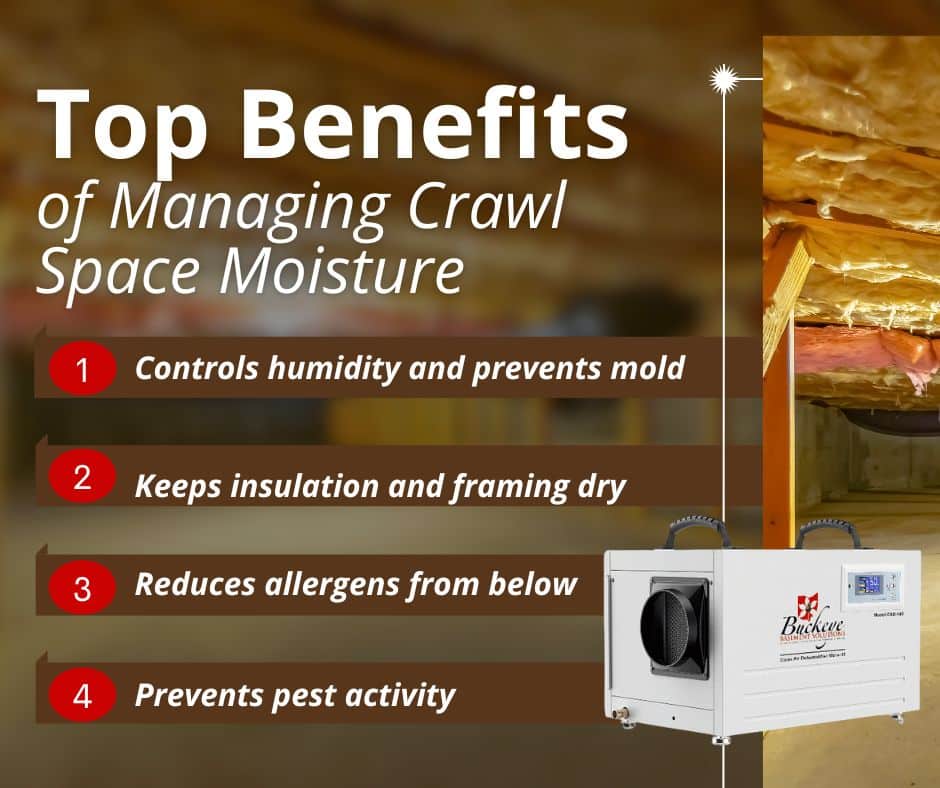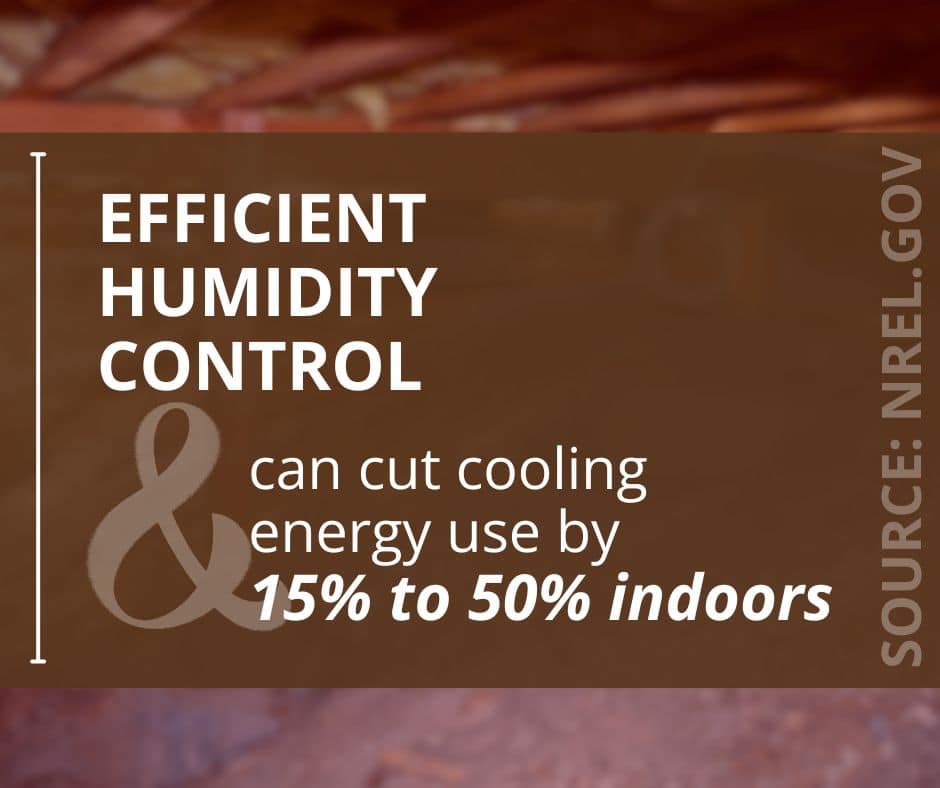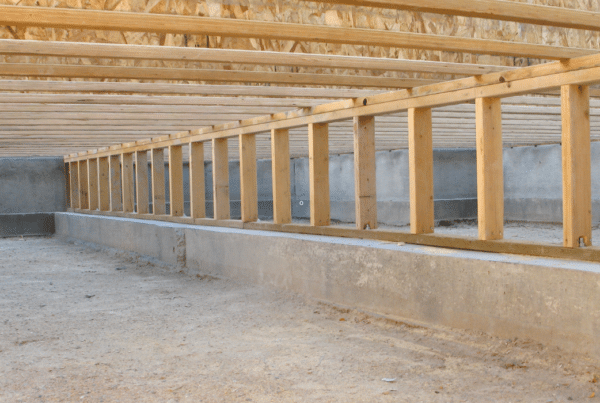If your home has a crawl space, you may not think about it often, but the conditions underneath your floors can have a major impact on the quality, moisture levels, and long-term health of your house. One of the simplest and most effective ways to manage the crawl space is with a dehumidifier.
In this guide, we’ll break down how crawl space moisture becomes a problem, what a crawl space dehumidifier does, and how it compares to a whole-home system.
The Problem: Moisture in the Crawl Space
Crawl spaces are often vented to the outside, unsealed, or filled with exposed dirt floors. That means they can easily absorb water from the surrounding soil, humid air, or plumbing leaks.
This moisture creates ideal conditions for mold growth, wood rot, and even pest infestations. According to the EPA, relative humidity above 60% encourages mold to grow on organic materials like wood, paper, or insulation. Many untreated crawl spaces exceed that threshold during the spring and summer months.
Beyond mold, moisture in the crawl space can also damage insulation, warp framing, and lead to higher energy costs due to reduced HVAC efficiency.
What a Crawl Space Dehumidifier Helps With
A crawl space dehumidifier helps you maintain a healthy humidity level (typically between 45% and 55%) in the area beneath your home.
Unlike standard home dehumidifiers, specialized crawl space models are built for tight, low-clearance environments and can operate consistently in fluctuating conditions.
When installed properly, a crawl space dehumidifier will…
- Pulls moisture out of the air before it reaches wood, insulation, or ductwork
- Maintains consistent humidity, even during rainy or humid weather
- Circulates air to prevent pockets of dampness
- Reduces mold spores and microbial growth
- Supports overall air quality throughout the home
This matters because much of the air in your home can originate from the crawl space. If the air down there is humid, musty, or moldy, it will travel into your living space, too.

Why It Matters for Midwest U.S. Homes
Certain weather patterns create a unique challenge for homeowners with crawl spaces. Snowmelt, spring rains, and humid summers contribute to consistently high ground moisture.
This means even homes without visible flooding or leaks can develop a wet crawl space.
Here’s what that can lead to over time:
- Structural Issues: Wooden joists and subflooring may absorb moisture, leading to sagging floors or compromised framing.
- Foundation Cracks: Hydrostatic pressure can increase around the perimeter walls, especially in homes with block foundations.
- Poor Indoor Air Quality: Moisture and mold in the crawl space can release spores and allergens into the air you breathe.
- Pest Problems: Termites, carpenter ants, rodents, and spiders all thrive in damp, dark environments.
- Insulation Failure: Wet insulation becomes ineffective and can harbor mold, reducing energy efficiency and increasing utility costs.
A crawl space dehumidifier acts as a line of defense against all of the above.
Crawl Space Dehumidifier vs Whole-Home Systems
Both crawl space and whole-home dehumidifiers play a key role in moisture control, but they’re designed for different parts of your home. If you want full protection, it’s not about choosing one or the other; just making sure each part of your home has the right solution in place.
A crawl space dehumidifier is built for small, enclosed areas with limited airflow. It targets the specific moisture problems that happen under your home, especially in humid seasons or wet soil conditions.
On the other hand, a whole-home dehumidifier system is designed to work with your HVAC setup and manage indoor humidity throughout your living space. It helps improve indoor air quality, reduce allergens, and make your home more energy-efficient overall.
At Buckeye Basement Solutions, we offer both. Our team can evaluate whether you need targeted moisture control in your crawl space, broader humidity management through a whole-home system, or a combination of both for the best long-term protection.
Dehumidifiers in Conjunction With Encapsulation
If your crawl space has already been encapsulated, a dehumidifier is essential.
Encapsulation creates a sealed environment by covering the walls and floors of the crawl space with a heavy-duty vapor barrier.
This barrier blocks outside moisture, but without a dehumidifier, residual humidity from plumbing lines, air exchange, or natural soil moisture can still build up.
Adding a crawl space dehumidifier ensures that the sealed space remains dry, balanced, and free from conditions that allow mold to grow.
According to a 2021 report from the Building Science Corporation, dehumidification is the single most important factor in maintaining post-encapsulation air quality.
Long-Term Benefits of Crawl Space Moisture Management
While it might seem like a niche upgrade, the benefits of crawl space dehumidification extend far beyond the space itself.
1. Protects Your Foundation and Structure
Dry, stable conditions help preserve framing, support beams, and floor joists, which keep your home level and strong.
2. Improves Air Quality
By reducing allergens, spores, and airborne moisture, a dehumidifier supports healthier breathing conditions indoors.
3. Lowers Energy Costs
Dry air requires less energy to heat and cool. A federally funded study found that efficient air dehumidification can cut cooling energy use by 15% to 50% indoors, showing just how important moisture control is for long-term savings and performance.
4. Deters Pests
Most crawl space pests prefer damp environments. Removing that moisture makes your home less appealing to them.
5. Preserves Insulation and Ductwork
Humidity can compress insulation and cause ductwork to rust or sweat. A crawl space dehumidifier helps protect both.

Signs You May Need a Dehumidifier
You don’t need to wait for visible mold to act. Here are some common red flags:
- Musty or earthy odors in the home
- Cold floors in winter or unusually warm floors in summer
- Increased allergy symptoms indoors
- Condensation on ductwork or crawl space walls
- Insect or rodent activity below the home
- Wood floor warping or creaking above the crawl space
- Visible water staining or dampness on crawl space surfaces
Other Related Questions Homeowners Ask
Does a dehumidifier run constantly in the crawl space?
It depends on the system and conditions, but most models are equipped with humidity sensors that turn on as needed. In wetter months, they may run more often.
Can I use a portable dehumidifier from a store?
No. Standard home models are not designed for crawl space conditions. They lack the power, durability, and drainage setup needed for long-term performance.
Do I need both encapsulation and a dehumidifier?
Yes, in most cases. Encapsulation blocks moisture from entering, while the dehumidifier removes what’s already there. Together, they form a complete moisture control solution.
What is the lifespan of a crawl space dehumidifier?
Most high-quality models last between 5 and 10 years with proper maintenance, which includes filter cleaning and drain line checks.
Will this help with musty smells in my house?
Yes. Since crawl space air often rises into your home, removing moisture and mold from below can significantly improve odors indoors.
When to Call a Professional
If your crawl space smells musty, feels damp, or is showing signs of rot or mold, it’s time to take a closer look. Installing a dehumidifier might sound simple, but choosing the right system and placing it correctly requires experience.
At Buckeye Basement Solutions, we expertly evaluate your crawl space, basement, and foundation. From drainage improvements and encapsulation to whole-home protection, we tailor each solution to your property and climate.
Conclusion
Your crawl space may be out of sight, but it shouldn’t be out of mind. Moisture that collects under your home can quietly lead to structural issues, mold problems, and rising energy bills.
A crawl space dehumidifier offers a targeted, effective way to protect your home from the bottom up.
If you’re dealing with musty smells, soft floors, or suspect your crawl space needs attention, don’t wait. Buckeye Basement Solutions is here to help you create a cleaner, healthier, and longer-lasting home, starting right under your feet.



